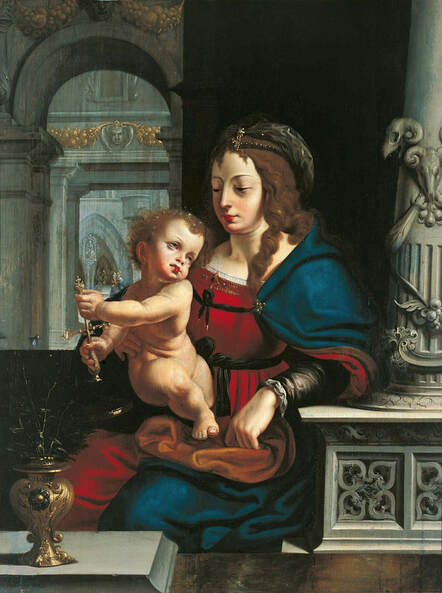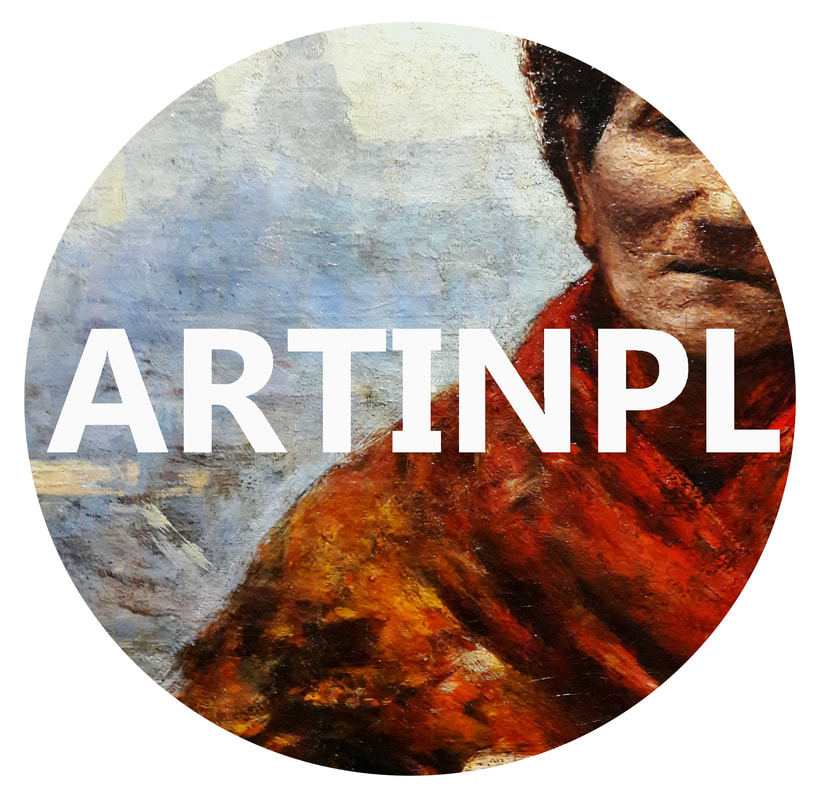|
Before 1516 the confraternity of Saint Reinhold in Gdańsk commissioned a retable for the Saint Reinhold Chapel of the Saint Mary's Church in the city. The outer wings of the polyptych were painted in the workshop of Joos van Cleve, who depicted himself as Saint Reinhold.
The polyptych was shipped to Gdańsk in 1516 and today is on display in the Gallery of Medieval Art of the National Museum in Warsaw (oak, central panel 194 × 158 cm (76.4 × 62.2 in), each wing 194 × 75 cm (76.4 × 29.5 in)). It is the first confirmed work commissioned by patrons from territories of today's Poland. The second could be Triptych with the Adoration of the Magi with a monarch in a chain of the Order of the Golden Fleece in the Gemäldegalerie, Berlin (oak, central panel 72 × 52 cm (28.3 × 20.5 in), each wing 69 × 22 cm (27.2 × 8.7 in)). It was acquired from the Reimer Collection in Berlin in 1843. Possibly commissioned by Sigismund I of Poland. The outer parts of the wings were painted en grisaille with effigies of Saints Christopher and Sebastian, which may indicate the donor, his patron saints, however among recipients of the Order of the Golden Fleece between 1451 and 1531 there were no Sebastian and only one Christopher - Christopher, Margrave of Baden-Hachberg (1453-1527). Although the latter was portraited in the similar headdress (crinale), he was not a king to depict himself as one of the Magi, and his facial features are completely different. Also other garments are very close to those from the known effigies of the Polish monarch - eg. Communion of Sigismund I, a leaf from the Prayer Book of Sigismund I the Old by Stanisław Samostrzelnik from 1524 in the British Library. The king of Poland was awarded the Order of the Golden Fleece in 1519 at the age of 52. The sources on artistic contacts of the Polish court at that time with the Netherlands are very scarce. Among commissions confirmed in preserved inventories and accounts there are the following. In 1526 queen Bona Sforza commissioned in Antwerp through Seweryn Boner, 16 tapestries "de lana cum figuris et imaginibus" of 200 flemish square inches in its entity. They were transported to Kraków via Frankfurt upon Main, Nuremberg and Wrocław. In 1533 king Sigismund I commissioned through Boner and Mauritius Hernyck in Antwerp 60 tapestries with coat of arms of Poland, Lithuania and Duchy of Milan among which 20 bigger with green and blue background, 26 tapestries without coat of arms and 6 tapestries with figural scenes. The commission cost was 1170 florins and tapestries were transported to Kraków via Nuremberg, Leipzig and Wrocław. In 1536 the king acquired 7 paintings in Flanders to adorn the apartments of prince Sigismund Augustus at the Wawel castle for 35 florins ("pro septem imaginibus Flandrensibus pictis"). The subtle marble bust of Queen Barbara Zapolya from Olesko Castle in the style of Netherlandish renaissance was probably part of a larger commission made by Sigismund I around 1520. Madonna and Child in architectural setting
oil on panel, ca. 1535, 33.6 × 25.2 cm (13.2 × 9.9 in), inventory number Wil.1591, Museum of King John III's Palace at Wilanów
The painting represents one of several versions of ''Madonna of the Cherries'' created by Giovanni Pietro Rizzoli, called Giampietrino in about 1508-1510 when he was working alongside Leonardo da Vinci. The Giampietrino's painting is possibly a reproduction of a Madonna painted by Leonardo for Francis I of France. The latter work was probably a painting that influenced Joos van Cleve who was frequently employed by French court. The painting by Giampietrino from doctor Karl Lanz's collection is a direct link to the lost da Vinci's original. The composition enjoyed great success in the early decades of the 16th century and some twenty three versions attributed to Joos van Cleve's workshop have been identified.
Similar painting is in the Arnold and Seena Davis Collection. The work was acquired by Stanisław Kostka Potocki for his collection in the Wilanów Palace in Warsaw.
In the beginning of the 17th century the medieval abode of the Dukes of Masovia was largely extended to house the parliament of the Polish-Lithuanian Commonwealth, offices and court of the Vasas. The Italian architects Giovanni Trevano, Giacomo Rodondo, Paolo de la Corte and Mateo Castello constructed a Mannerist-early Baroque five-sided palace between 1598-1619. In 1621-1627, with the threat of Ottoman invasion, the palace was fortified with a curtain wall from the Vistula according to Italian concept of palazzo in fortezza (meaning in Italian, "a palace in a fortress"). Between 1634 and 1637 a large hall was constructed in upper parts of the southern wing to house opera hall of King Ladislaus IV and in 1637 the staircase tower was largely remodelled (Ladislaus' Tower). In 1643 the Prince-Cardinal Charles Ferdinand Vasa's Palace was erected on the northern bastion of the Castle's curtain wall and in 1644 a new gate (Saint John's Gate) and the Sigismund Column were erected by royal architect Constantino Tencalla in Baroque style.
During the so-called Deluge of the Polish-Lithuanian Commonwealth (invasion of allied forces of Sweden from north, Brandenburg from west, Transilvania from south and Muscovy from East), the castle was devastated in three occupations by foreign forces between 1655-1656 (the last was Transilvanian occupation). All valuables, including marble pavements, chimneys and window sills were shipped to Sweden, while the interiors were turned into stables and a hospital. Exterior and interior
(1) Detail of the Plan of Warsaw in 1656 by Nicolas Pérelle after Erik Dahlbergh, printed in 1696. The fortifications of the Royal Castle in Warsaw were built in the years 1596-1627 giving the structure the more modern appearance according to principles of the Old Italian School (circle of Antonio da Sangallo). They consisted of a 162-metre-long curtain wall flanked by bastions on either side. Two shorter walls connected the bastions with the Castle. The wall rose at least 6.70 metres above the ground level. The fortifications were made of granite rocks, and due to the instability of the terrain, oak piles were also driven into the ground, the basic material for the surface construction was limestone surmounted with bricks. The remnants of the fortifications were absorbed by subsequent buildings in the 18th-century.
Map legend
(2) Sigismund III Vasa on catafalque by Christian Melich, 1633, Wawel Royal Castle.
(3-4) The Ladislaus Tower of the Castle, 1637. Tiles from the excavations in the Royal Castle's garden, 1630s: (5) Tile with eagles from a stove, (6) Stove tile with a lion or a griffon, (7) Dutch tile with a soldier. Portraits
(1-2) Portrait of Sigismund III Vasa and Constance of Austria by Philipp Holbein II or workshop, ca. 1625, Royal Castle in Warsaw.
(3) Portrait of Philip III of Spain by Andrés López Polanco, ca. 1617, Skokloster Castle, possibly from the collection of Sigismund III Vasa. In 1615 Queen Constance of Austria, Sigismund's second wife, ordered the Commonwealth's ambassador in Spain to ask for the portraits of the members of the Spanish Royal family. Her elder sister Margaret of Austria, was a wife of King Philip III of Spain. Since the new Holy Roman Emperor, Matthias, resided more frequently in Vienna then in Prague from 1612, the portraits of Spanish Habsburgs would be sent to Vienna after this date, consequently it is more probable that the Philip III's portrait was captured by Swedish forces in Warsaw and not in Prague. (4-5) Portraits of two sisters, daughters of Philip III of Spain and Margaret of Austria: Empress Maria Anna of Spain by Frans Luycx, ca. 1638 and Anne of Austria, Queen of France by Charles Beaubrun, ca. 1645. Both portraits were given to the Visitationist Monastery in Warsaw by John II Casimir Vasa in September 1668 and by most accounts adorned Castle walls. (6) Portrait of Eleonora Gonzaga (1630-1686) by Frans Luycx, ca. 1651, Nationalmuseum in Stockholm. A portrait of a relative to Queen Marie Louise Gonzaga and a wife of Emperor Ferdinand III, cousin of John II Casimir Vasa was sent to Warsaw and was captured by Swedes in 1655 (from the collection of Gripsholm Castle).
See more pictures of the Royal Castle in Warsaw during the Vasas on Pinterest - Artinpl and Artinplhub
|
Artinpl is individual, educational project to share knowledge about works of art nowadays and in the past in Poland.
If you like this project, please support it with any amount so it could develop. © Marcin Latka Categories
All
Archives
April 2023
|





